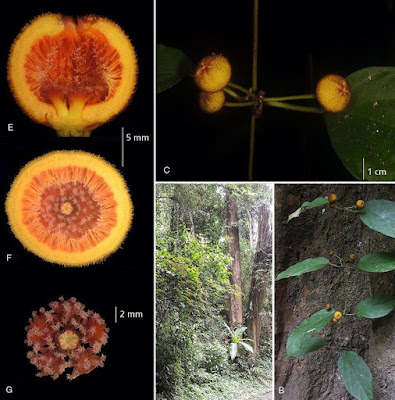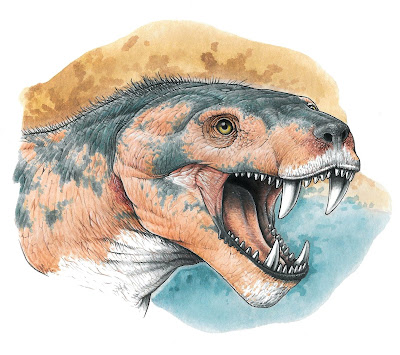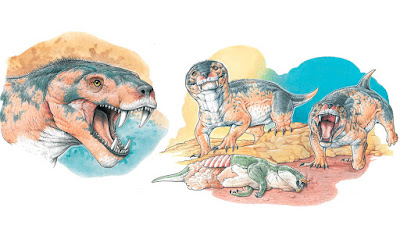[Most Recent Entries] [Calendar View]
Thursday, July 4th, 2019
| Time | Event | ||||||
| 2:37a | [Botany • 2019] Heterostemma ficoides (Apocynaceae: Asclepiodoideae) • A New Species with Fig-like Flowers from Northern Thailand Heterostemma ficoides A.Kidyoo, a new species of Heterostemma sect. Oianthus with a fig-like flower discovered in northern Thailand is here described. Photographs, line illustrations and detailed comparison with the similar species, H. vasudevanii Swarupan. & Mangaly are provided. Heterostemma ficoides resembles H. vasudevanii in having a fleshy globose flower and the presence of the inner corona appendages, but clearly differs in leaf shape, leaf venation, presence of dense hairs on the outer and inner surfaces of the corolla, and apex of the staminal corona lobes. An identification key to the species of sect. Oianthus is presented. Keywords: Ceropegieae, evergreen forest, inner corona appendages, sect. Oianthus
Heterostemma ficoides A. Kidyoo sp. nov. Etymology. The specific epithet ‘ficoides’ alludes to the striking similarity of its flower to a fig of Ficus species. Aroonrat Kidyoo. 2019. Heterostemma ficoides (Apocynaceae: Asclepiadoideae), A New Species with Fig-like Flowers from Northern Thailand. Kew Bulletin. DOI: 10.1007/s12225-019-9815-4 | ||||||
| 3:34a | [Entomology • 2019] Lebinthus sandakan • Crickets of the Subfamily Eneopterinae (Orthoptera: Grylloidea) from Sandakan, Sabah: One New Species and Calling Songs of Cardiodactylus borneoe, A Sympatric Species
Abstract Orthoptera from Sandakan, Sabah are relatively understudied compared to some other parts of Borneo, and lack of information of species there can impede our understanding of the origins and biodiversity of orthopterans in Borneo and, in general, Southeast Asia. Based on a recent orthopteran survey in Sandakan, one new species of Lebinthus Stål is described: Lebinthus sandakan sp. nov. The male calling song of this new species is also presented. The calling song of Cardiodactylus borneoe Robillard & Gorochov, 2014 is also described for the first time. Keywords: Orthoptera, bioacoustics, Borneo, new species, Southeast Asia, taxonomy Tan Ming Kai, Razy Japir, Arthur Y.C. Chung and Tony Robillard. 2019. Crickets of the Subfamily Eneopterinae (Orthoptera: Grylloidea) from Sandakan, Sabah: One New Species and Calling Songs of A Sympatric Species. Zootaxa. 4619(2); 347–363. DOI: 10.11646/zootaxa.4619.2.9 | ||||||
| 3:44a | [Paleontology • 2019] Vetusodon elikhulu • A New Large Cynodont from the Late Permian (Lopingian) of the South African Karoo Basin and its Phylogenetic Significance
Abstract The Karoo Basin of South Africa has the best global record of Lopingian (Late Permian) non-mammaliaform cynodonts, currently represented by five species. We describe Vetusodon elikhulu gen. et sp. nov., documented by four specimens from the Daptocephalus Assemblage Zone. With a basal skull length of ~18 cm, it is the largest Lopingian cynodont and is also larger than Induan representatives of the group. Vetusodon elikhulu has a cranial morphology that departs notably from that previously documented for Permo-Triassic cynodonts. It features a short and extremely wide snout, resembling that of the contemporaneous therocephalian Moschorhinus, and has large incisors and canines that contrast with the small unicusped postcanines, suggesting a more important role of the anterior dentition for feeding. The dentary is extremely long and robust, with the posterior margin located closer to the craniomandibular joint than in other Lopingian and Induan cynodonts (e.g. Thrinaxodon). The secondary palate morphology of V. elikhulu is unique, being short and incomplete and with the posterior portion of the maxilla partly covering the vomer. A phylogenetic analysis suggests that V. elikhulu is the sister taxon of Eucynodontia and thus the most derived of the Lopingian to Induan cynodonts yet discovered. Keywords: anatomy, Changhsingian, epicynodont, Gondwana, phylogeny
Vetusodon elikhulu gen. et sp. nov. Fernando Abdala, Leandro C. Gaetano, Roger M. H. Smith and Bruce S Rubidge. 2019. A New Large Cynodont from the Late Permian (Lopingian) of the South African Karoo Basin and its Phylogenetic Significance. Zoological Journal of the Linnean Society. zlz004. DOI: 10.1093/zoolinnean/zlz004 Vetusodon elikhulu: when the old has something modern conicet.gov.ar/vetusodon-elikhulu-when-t | ||||||
| 10:04a | [Botany • 2019] Themeda palakkadensis (Poaceae: Panicoideae) • A New Species from Kerala State, India
Abstract Themeda palakkadensis, a new grass species from Kerala, India, is described and illustrated. The new species is similar to T. laxa in having pair of involucral spikelets arranged at same level and in inflorescence pattern but, differs in having densely rufous hairy sessile spikelets, lower lemma of sessile spikelet sparsely rufous hairy, lower glumes of pedicelled spikelets winged on keels, longer anthers and shorter caryopsis length. Keyword: Andropogoneae, Anthistirineae, Panicoideae, Poaceae, Themeda palakkadensis, Western Ghats Themeda palakkadensis Chorghe, K. Prasad & Lakshmin., sp. nov. Diagnosis: Themeda palakkadensis is similar to T. laxa in having involurcral spikelets arranged at same level and spathe having 1–3 racemes arranged, but differs from it in having both the glumes of sessile spikelet densely rufous hairy (vs glabrous), lower lemma of sessile spikelet sparsely rufous hairy at apex (vs glabrous); anthers 4–5 mm long (vs 2–3 mm); caryopsis 2.5–3 mm long (vs 3.5– 4 mm long) and lower glumes of pedicelled spikelet winged on both the keels (vs wingless). Etymology: The new species is named after Palakkad District of Kerala state. Alok R. Chorghe, Kothareddy Prasad and Pakshirajan Lakshminarasimhan. 2019. Themeda palakkadensis (Poaceae: Panicoideae), A New Species from Kerala State, India. Taiwania. 64(3); 231-234. tai2.ntu.edu.tw/taiwania/abstract.php?ty |
| << Previous Day |
2019/07/04 [Calendar] |
Next Day >> |












